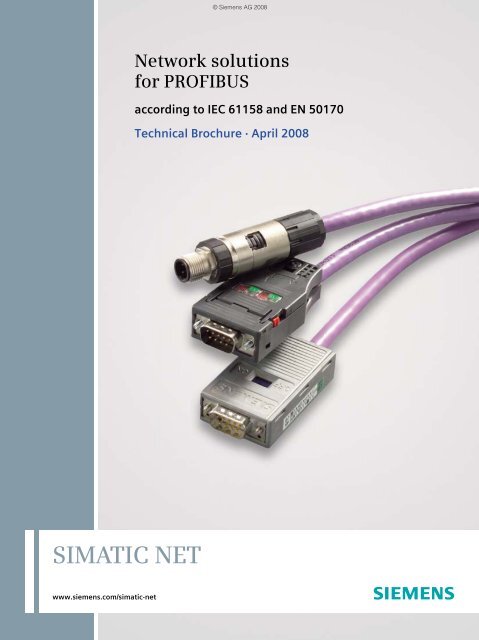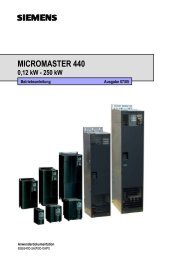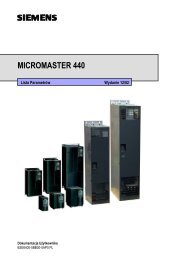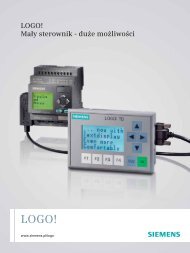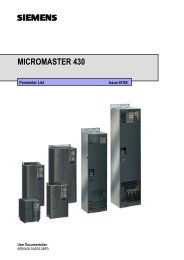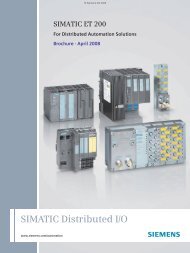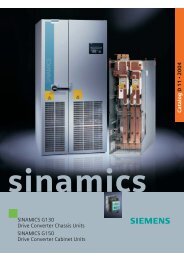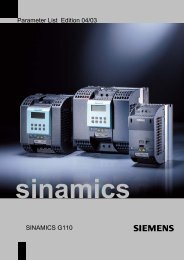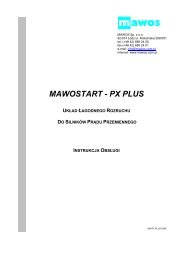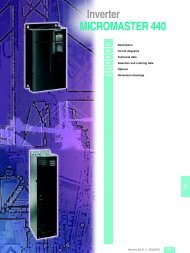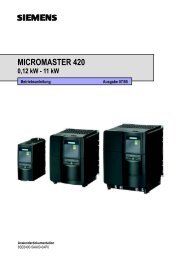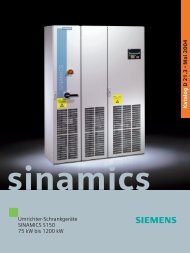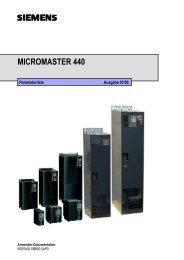Network Solutions for PROFIBUS
Network Solutions for PROFIBUS
Network Solutions for PROFIBUS
Create successful ePaper yourself
Turn your PDF publications into a flip-book with our unique Google optimized e-Paper software.
© Siemens AG 2008SIMATICPDMIsochronous modeThe CPU, I/O and user program are synchronized with the<strong>PROFIBUS</strong> cycle. The "isochronous mode" function issupported by the CPUs of the SIMATIC S7-400, SIMOTION,SINUMERIK and servo drives. The drives are controlled usingthe PROFIdrive profile.SIMATIC HMIS7-400S7-300<strong>PROFIBUS</strong> PA(Process Automation)expands <strong>PROFIBUS</strong> DP with intrinsically-safe transmission ofdata and power (e.g. transducers in the food and beveragesindustry) in accordance with the international standardIEC 61158-2 (same protocol, different physical properties).<strong>PROFIBUS</strong> FMS(Fieldbus Message Specification)<strong>for</strong> data communication of automation systems from differentmanufacturers. This enables precise, distributed implementationnot only of motion control tasks, but also of generalclosed-loop control and measuring tasks.<strong>PROFIBUS</strong>-FMSSIMATIC C7Example of a <strong>PROFIBUS</strong> FMS configurationField PG MG_IK10_XX_50029<strong>PROFIBUS</strong> – system overview 5
© Siemens AG 2008<strong>PROFIBUS</strong> – system overviewApplication optionsFactory automationIt is possible to use <strong>PROFIBUS</strong> DP in, <strong>for</strong> example, the food andbeverages industry, to implement production lines with variablespeeds or options <strong>for</strong> controlling the plant during operation.Many variables have to be flexible in order to allow fault-freeproduction. Plant availability is becoming increasingly important.A downtime caused by a repair is usually more expensive thancontrolled monitoring of systems <strong>for</strong> wear or possible faults.By using high-per<strong>for</strong>mance components in the communication,<strong>for</strong> example, errors can be located and reported quickly.Factory automationProcess automationProcess automation has high per<strong>for</strong>mance and reliabilityrequirements and demands simple and safe operation ofplants.<strong>PROFIBUS</strong> PA uses the intrinsically safe transmission technologyspecified in the international IEC 61158-2 standard. Thisallows field devices to be integrated into the hazardous zone.The basis <strong>for</strong> this is <strong>PROFIBUS</strong> DP that has been expanded <strong>for</strong>intrinsically-safe operation.The acyclic communication services of <strong>PROFIBUS</strong> DP(V1)/PAallow online access to device parameters, that is, the processcontrol systems have direct access to the actual status of thefield device data and to the status and diagnostics messages.Using <strong>PROFIBUS</strong> DP(V1)/PA, the field devices become an integralcomponent of the company-wide automation conceptfrom open-loop and closed-loop control right up to assetmanagement, including spare parts management and warehousemanagement.Process automation6<strong>PROFIBUS</strong> – system overview
© Siemens AG 2008Building automationThe networking of large buildings or parts of buildings allowscentralized or distributed access to all stations.Electrical installation systems are found not only in residentialand non-residential buildings but also in every industrialplant. Most devices and also many building systems such aslighting, heating, air conditioning, fans, blinds, or accesscontrols are operated almost without exception with electricpower. These systems, just like those in industrial automation,must be regulated, controlled, and monitored.Building automation<strong>PROFIBUS</strong> – system overview 7
© Siemens AG 2008<strong>PROFIBUS</strong> – system overview<strong>Network</strong>ing optionsS7-400 with CP 443-5PC with CP 5613 A2<strong>PROFIBUS</strong> DPDP/PACoupler/LinkET 200MET 200SRepeaterIntrinsically-safe area<strong>PROFIBUS</strong> PAET 200iSPRS 485iSCouplerRepeaterDrivesET 200proET 200proG_IK10_XX_50012Electrical <strong>PROFIBUS</strong> network configurationSiemens offers a comprehensive range of <strong>PROFIBUS</strong> networkcomponents <strong>for</strong> electrical, optical, and wireless transmissiontechnology.<strong>PROFIBUS</strong> is standardized in accordance with IEC 61158/EN 50170 <strong>for</strong> universal automation (<strong>PROFIBUS</strong> FMS and<strong>PROFIBUS</strong> DP), and in accordance with IEC 61158-2 <strong>for</strong> processautomation (<strong>PROFIBUS</strong> PA).8<strong>PROFIBUS</strong> – system overview
© Siemens AG 2008<strong>Network</strong>ing options – electrical networksThe electrical network uses a shielded, twisted pair cable.The RS485 interface works with voltage differences. It isthere<strong>for</strong>e less sensitive to interference than a voltage or currentinterface.With <strong>PROFIBUS</strong>, the stations are connected to the bus via a busterminal or a bus connector (max. 32 stations per segment).The electrical network can be configured as a bus or tree structure.The individual segments are connected via repeaters.The transmission rate can be set in steps from 9.6 Kbit/s to12 Mbit/s in accordance with IEC 61158/EN 50170.The maximum segment length depends on the transmissionrate.For applications in the intrinsically-safe area the transmissiontechnology compliant with IEC 61158-2 is used with<strong>PROFIBUS</strong> PA. The transmission rate in this case is 31.25 Kbit/s.Features of the electrical network• Transmission procedure in accordance with IEC 61158/EN 50170 <strong>for</strong> universal automation (<strong>PROFIBUS</strong> FMS/DP),and in accordance with IEC 61158-2 <strong>for</strong> the intrinsicallysafearea (<strong>PROFIBUS</strong> PA)• High-grade bus cable• Transmission method: RS485 (in accordance with EIA)• Bus topology with bus terminals and bus connectors <strong>for</strong>connecting <strong>PROFIBUS</strong> stations• <strong>Network</strong> is immune to interference thanks to doubleshieldedcables and a simple, uni<strong>for</strong>m installation andgrounding concept• Simple and fast connector assembly with FastConnect• The DP transmission system of RS485 (bit coding by meansof differential voltage signals) is converted to IEC 61158-2(bit coding by means of current signals) using the networkcomponents (DP/PA coupler or DP/PA link)• Versatile application due to special bus cables<strong>PROFIBUS</strong> cables with cable connectors<strong>PROFIBUS</strong> FastConnect stripping tool<strong>PROFIBUS</strong> – system overview 9
© Siemens AG 2008<strong>PROFIBUS</strong> – system overview<strong>Network</strong>ing options – optical networks<strong>Network</strong> configuration of optical <strong>PROFIBUS</strong> with OLMsThe optical network uses fiber-optic cables as the transmissionmedium. The fiber-optic cable is provided with a coating.The term "fiber" is often also used <strong>for</strong> fiber-optic cables (FOC).Optical networks are especially suitable <strong>for</strong> long ranges. Thereis a choice between plastic, PCF or glass fiber-optic cables.Features of the optical network• The transmission link is insensitive to electromagneticinfluences• It is suitable <strong>for</strong> long ranges• Galvanic isolation is implemented• You can choose between plastic, PCF or glass fiber-opticcables• It is tap-proof since no radiation is emitted from the line• It is easy to lay since the cable is light-weight and preassembled,and there are no grounding problems• No additional lightning protection concept is required inthe outdoor area• Rugged construction of the fiber-optic cable <strong>for</strong> industrialapplications both indoors and outdoors• The fiber-optic cables galvanically isolate the modules.Fiber-optic standard cable with connector10<strong>PROFIBUS</strong> – system overview
© Siemens AG 2008PG/PC/OPwith 5613 FOS7-300with CP 342-5 FOET 200Swith IM 151 FOET 200Mwith IM 153-2 FODP node withoutintegral optics830-1connecting cable<strong>PROFIBUS</strong>OBTFOCBus cable<strong>for</strong> <strong>PROFIBUS</strong>Single connection lengths:plastic to 50 m, PCF to 300 mAdditionalnodesG_IK10_XX 50107<strong>Network</strong> configuration of optical <strong>PROFIBUS</strong> DP with <strong>PROFIBUS</strong> OBTOptical <strong>PROFIBUS</strong> with OLMsUsing optical link modules (OLMs) it is possible to constructan optical network in a linear, ring, or star topology. A networktopology <strong>for</strong> increased availability requirements can be establishedusing the redundant ring structure.The maximum distance between two OLMs is 15 km.The transmission rate can be set in steps from 9.6 Kbit/s to12 Mbit/s.Optical <strong>PROFIBUS</strong> with integral interface and OBTThe optical <strong>PROFIBUS</strong> with integral interface and OBT isconstructed in a linear topology. A cost-optimized solution isavailable <strong>for</strong> this in the <strong>for</strong>m of devices with integral opticalinterface. Terminal equipment with an RS485 interface can beconnected via an Optical Bus Terminal (OBT). The maximumdistance between two stations is 50 m in the case of plasticfiber-optic cable.To cover distances of up to 300 m, special fiber-optic cablesare offered.<strong>PROFIBUS</strong> OLM<strong>PROFIBUS</strong> OBT<strong>PROFIBUS</strong> – system overview 11
© Siemens AG 2008<strong>PROFIBUS</strong> – system overview<strong>Network</strong>ing options – mixed networks Electrical and optical <strong>PROFIBUS</strong> in star topologyHybrid electrical and optical networks are possible. The transitionbetween both media is implemented by the OLM.In station-to-station communication on the bus, there is nodifference between two-wire technology and fiber-optic technology.A maximum of 127 stations may be connected to one<strong>PROFIBUS</strong> network.Glass fiber-optic cables <strong>for</strong> <strong>PROFIBUS</strong><strong>PROFIBUS</strong> OLM12<strong>PROFIBUS</strong> – system overview
© Siemens AG 2008<strong>PROFIBUS</strong> – system overviewFastConnect – the complete systemThe FastConnect stripping technology facilitates swift andsimple connection of <strong>PROFIBUS</strong> connectors to the <strong>PROFIBUS</strong>cables.The special design of the FastConnect bus cables permits theuse of the FastConnect stripping tool, with which the outersheath and the braided shield can be removed to measure inone operation. Cables prepared in this way are attached to theFastConnect bus connectors using the insulation displacementmethod.The system comprises three components that are coordinatedwith one another:• FastConnect bus cables <strong>for</strong> quick assembly• FastConnect stripping tool• FastConnect bus connector <strong>for</strong> <strong>PROFIBUS</strong>The <strong>PROFIBUS</strong> FastConnect bus cables can also be connectedto the conventional bus connectors.Advantages of the FastConnect systemInitial position of the stripping tool(FCS) in the right handInserting the measured end ofthe cable into the tool as far as theindex finger of the right hand.Measuring the cable length byplacing the cable on the template.End stop with the index finger ofthe left hand.Clamping end of cable in FCSas far as end stop.■Reduction of the connection times of terminals byremoving the outer sheath and braided shield in oneoperation■■Assembly errors such as short-circuit between shieldand core are preventedSimple assembly operations thanks to preset FC strippingtoolTurn FCS four times in directionof arrow.Pull FCS off end of cable while stillclosed.■Contact assignment can be checked in the closedstate by means of the transparent cover on the insulationpiercing connecting devices and color coding■FastConnect connecting system available in degreesof protection IP20 and IP65.Cable off-cuts remain in the FCS.After unclamping the FCS,the off cuts can be removed.Insert cores into the connectoraccording to color coding, pressthe interlock down and tighten thestrain relief screw.Finished!PB FC M12 PlugPRO pre-assembled14<strong>PROFIBUS</strong> – system overview
© Siemens AG 2008The SpliTConnect systemSpliTConnect <strong>for</strong> fieldbus systems is used <strong>for</strong> constructingfieldbus segments as per IEC 61158-2 (e.g. <strong>PROFIBUS</strong> PA) withfield device interface points.The bus cable is easy to assemble thanks to the FastConnectsystem (FastConnect stripping tool, FC Process Cable compliantwith IEC 61158-2).The FC Process Cable is stripped as with FastConnect.Additional grounding of the SpliTConnect Tap can be implementedusing a contacting screw.The terminal devices can be connected using the FC ProcessCable in accordance with IEC 61158-2 or the SpliTConnectM12 Outlet/M12 Jack. The SpliTConnect Coupler can be usedto construct a <strong>PROFIBUS</strong> PA hub by connecting SpliTConnectTaps in series.By replacing the contacting screw with the SpliTConnectTerminator, the SpliTConnect Tap can be used as a bus terminatingelement.SpliTConnect Tap and TerminatorSpliTConnect M12 OutletSpliTConnect CouplerSpliTConnect M12 JackAdvantages of SpliTConnect■■■■■The connection times of terminals are reduced by fastand easy removal of the outer sheath and braidedshield in one operationSimple assembly operations thanks to preset FCstripping toolConnection of the terminal device is facilitated by useof the FastConnect systemWidely diverse uses possible thanks to the modularSpliTConnect systemReduction in number of types and parts thanks touni<strong>for</strong>m connection system <strong>for</strong> <strong>PROFIBUS</strong> PA<strong>PROFIBUS</strong> – system overview 15
© Siemens AG 2008<strong>Network</strong> componentsPassive network components: Electrical bus cablesCable type Designation Features Fields of applicationFor the construction of <strong>PROFIBUS</strong>networks, the following different typesof silicon-free cable are offered <strong>for</strong> thedifferent applications:Bus cableswithFastConnecttechnologyQuick and easy connectorassembly using thestripping tool.Shielded twisted-paircables constructed withradial symmetry.<strong>PROFIBUS</strong>FC Standard Cable GP■ Standard cable <strong>for</strong> universalapplicationsFC Robust Cable■ Special cable <strong>for</strong> chemically and mechanicallydemanding environmentsFC Food Cable■ Special cable <strong>for</strong> the food andbeverages industryFC Ground Cable■ Special cable <strong>for</strong> routing undergroundFC Flexible Cable■ Special cable <strong>for</strong> use in cable carriersFC Trailing Cable■ Trailing cable <strong>for</strong> moving machineparts (stranded)FC FRNC Cable GP■ Halogen-free and flame-retardantcableFC Process Cable GP■ Bus cable <strong>for</strong> fieldbus systemscompliant with IEC 61158-2(hazardous and non-hazardous areas)Bus cableswithoutFastConnecttechnology<strong>PROFIBUS</strong>Festoon Cable GPShielded, twisted-paircable with circular crosssection;sold by the meter■ Special cable <strong>for</strong> festoon suspensionTorsion Cable■ Special cable <strong>for</strong> use on machineparts where the cable is subject totorsion (stranded)ECOFAST Hybrid Cable GP■ Hybrid cable <strong>for</strong> data transmissionand voltage supply to ECOFASTstations (stranded)SIENOPYR Marine Cable■ Halogen-free, tread-resistant,flame-retardant and marine approvedcable <strong>for</strong> permanent laying in shipsand offshore installationsThe following applies <strong>for</strong> all <strong>PROFIBUS</strong> connecting cables:• Due to the double shielding, they are particularly suitable<strong>for</strong> laying in industrial environments subject to electromagneticinterference.• A consistent grounding concept can be implementedvia the outer sheath and the ground terminals of the busterminal.• The printed meter marks simplify assembly.16<strong>Network</strong> components
© Siemens AG 2008Cable type Designation Features Fields of applicationConnectingcables<strong>PROFIBUS</strong>connecting cable 830-1TTwisted-pair conductors(cores of stranded copper)with a braided shield and a9-pin Sub-D connector ateach end. Both ends of thecable are terminated with aresistor combination(not switched).The <strong>PROFIBUS</strong> connecting cable 830-1Tcan be used to establish the connectionbetween an electrical <strong>PROFIBUS</strong> interfaceand a <strong>PROFIBUS</strong> station (OLM, OBTand end station) at up to 12 Mbit/s.<strong>PROFIBUS</strong>connecting cable 830-2<strong>PROFIBUS</strong> standard buscable pre-assembled withtwo 9-pin connectors(angled at 90°). One connectorof the pre-assembledconnecting cable isequipped with a programmingdevice interface.The connecting cable 830-2 is used<strong>for</strong> connecting <strong>PROFIBUS</strong> stations(e.g. HMI) to PLCs at transmission ratesof up to 12 Mbit/s.<strong>PROFIBUS</strong>M12 connecting cable 1)Pre-assembled connectingcable (<strong>PROFIBUS</strong> FC TrailingCable) with two 5-pin M12plugs/socketsThe <strong>PROFIBUS</strong> M12 connecting cable isused <strong>for</strong> connecting <strong>PROFIBUS</strong> stations(e.g. SIMATIC ET 200) with degree ofprotection IP65Hybrid7/8" connecting cable 1) Pre-assembled connectingcable with two 5-pin 7/8"plugs/sockets<strong>PROFIBUS</strong>Hybrid Standard Cable GP<strong>PROFIBUS</strong>Hybrid Robust CableHybrid cable with twoenergy cores (1.5 mm²),sold by the meterThe 7/8" connecting cable is used <strong>for</strong>supplying energy to <strong>PROFIBUS</strong> stations(e.g. SIMATIC ET 200) with degree ofprotection IP65The hybrid cable is used <strong>for</strong> supplyingdata and energy to the ET 200proCable versions:■ Standard cable <strong>for</strong> universal applications■ Rugged, trailing-type and weldspatter-proof hybrid cable, e.g. <strong>for</strong>use in welding cells1) For special lengths with 180° or 90° cable outlet, seehttp:L//support.automation.siemens.com/ww/view/en/26999294<strong>Network</strong> components 17
© Siemens AG 2008<strong>Network</strong> componentsPassive network components: Optical bus cablesCable type Designation Features Fields of applicationFiber-opticGlass fiber, sold by themeter or pre-assembledwith 4 BFOC or SC connectorsFor indoor and outdoorinstallationCable versions:FO Standard Cable GP(50/125)FO Ground Cable(50/125)FO Trailing Cable GP(50/125)FO Trailing Cable (50/125)SIENOPYR marine-duplexfiber-optic cable(62.5/125)<strong>PROFIBUS</strong> PlasticFiber-OpticDuplex corePlastic/PCF fiber-optic cable;sold by themeter or pre-assembled■ Rugged standard cable<strong>for</strong> universal applications■ Cable protected against the ingress ofwater lengthwise and transversely <strong>for</strong>installation outdoors; with non-metallicrodent protection;underground laying possible■ Cable <strong>for</strong> use in cable carriers■ Halogen-free, tread-resistant, flameretardantand marine-approved cable<strong>for</strong> laying in ships and offshore unitsPlastic and PCF fiber-optic cables areused <strong>for</strong> the construction of optical<strong>PROFIBUS</strong> DP networks in indoor applications.■ Up to 80 mwith low mechanical loads,e.g. laboratory structuresStandard cable ■ Up to 50 m,with Kevlar tension elements<strong>PROFIBUS</strong> PCFPlastic Fiber Opticstandard cable■ Up to 400 m,with Kevlar tension elements18<strong>Network</strong> components
© Siemens AG 2008Active network components: Electrical networkBus connectorThe RS 485 bus connectors <strong>for</strong> <strong>PROFIBUS</strong> are used <strong>for</strong> connectinga <strong>PROFIBUS</strong> station or a <strong>PROFIBUS</strong> network component tothe bus cable <strong>for</strong> <strong>PROFIBUS</strong>.There are different versions of the bus connectors in Sub-D,RJ45 or M12 connection technology that are optimized <strong>for</strong> thedevices to be connected.Bus terminalsThe <strong>PROFIBUS</strong> bus terminals enable connection of a bus nodeto a <strong>PROFIBUS</strong> network.Different versions are available:• Up to 1.5 Mbit/s: RS 485 bus terminal• Up to 12 Mbit/s: 12M bus terminalThe bus terminals have a prepared device connection <strong>for</strong><strong>PROFIBUS</strong> stations. Stations are connected to <strong>PROFIBUS</strong> networksby simply connecting Sub-D connectors to the spur line.Multi-point connections can be implemented by directly liningup several bus terminals (up to 32 stations per segment) atbus terminal 12M.Active terminating elementThe active RS 485 terminating resistor is used to terminate bussegments. Power supply is independent of the bus stations.Separately from the other I/O components, the terminatingresistor is supplied with a permanent voltage or with a voltageswitched from the I/O. By terminating the bus system, thestations (e.g. ET 200M/S) can be freely connected and disconnectedwithout malfunctions.Repeater RS 485The RS 485 repeater with IP20 connects two <strong>PROFIBUS</strong> or MPIbus segments in RS 485 technology with up to 32 stations,including repeaters. It enables transfer rates from 9.6 Kbit/s to12 Mbit/s (including 45.45 Kbit/s <strong>for</strong> <strong>PROFIBUS</strong> PA).The repeater is used <strong>for</strong>:• Increasing the number of stations (up to 127)and expansion• Galvanic isolation of segments• Regeneration of the signals in amplitude and time<strong>PROFIBUS</strong> bus connector<strong>PROFIBUS</strong> bus terminalRepeater RS 485M12 connectorActive terminating element<strong>Network</strong> components 19
© Siemens AG 2008<strong>Network</strong> componentsActive network components: Electrical networkDiagnostics repeaterSTEP 7 or COM <strong>PROFIBUS</strong> prompts the diagnostics repeater todetermine the topology of the bus system and saves it in theinternal diagnostics memory.If a fault occurs, the repeater automatically transmits a standarddiagnostic message to the bus master with the followingin<strong>for</strong>mation:• Affected segment• Fault location (e.g. between station X and Y)• Distance of the fault location from station X or Y as well asfrom the repeater in meters• Type of faultThe following faults are diagnosed:• Break in data lines A, B• Data-line-to-shield short circuit• Bus terminating resistor missingSporadic errors are also detected. The error messages aredisplayed graphically in STEP 7 and COM <strong>PROFIBUS</strong>. They arecompletely integrated into the SIMATIC system diagnostics(e.g. overview diagnostics, "Report system error" function).Power Rail BoosterThe Power Rail Booster enables a <strong>PROFIBUS</strong> DP connection viacontact conductors as used, <strong>for</strong> example, on suspendedmonorail conveyors or high-bay storage and retrieval systems.The diverse <strong>PROFIBUS</strong> DP system capabilities, such as diagnosticsand PROFIsafe safety engineering over the bus, can continueto be used.BT 200 hardware testerThe <strong>PROFIBUS</strong> line can be tested during the installation phasewith the BT 200 tester. Installation errors are found quicklyand simply and the installation engineer requires no specialknowledge of <strong>PROFIBUS</strong>.Even be<strong>for</strong>e commissioning of the plant it is possible to testthe RS 485 interface of the <strong>PROFIBUS</strong> DP slave with theBT 200. Outputting a list of accessible slaves on the pre-wiredbus is also possible, and this without a master on<strong>PROFIBUS</strong> DP.Diagnostics repeaterBT 200 hardware testerPower Rail Booster20<strong>Network</strong> components
© Siemens AG 2008Active network components: Optical networkOptical Link Module OLMWith the <strong>PROFIBUS</strong> OLM (Optical Link Modules), optical<strong>PROFIBUS</strong> networks can be established in linear, star and redundantring topologies. The transfer rate of a fiber-optic lineis independent of the distance and can be up to 12 Mbit/s.Possible applications <strong>for</strong> OLMs include:• System buses based on <strong>PROFIBUS</strong>• <strong>Network</strong>ing between buildings using glass fiber-optic cable• Mixed networks with electrical and optical segments• <strong>Network</strong>s covering a wide area(road tunnels, traffic control systems)• <strong>Network</strong>s with high availability requirements(redundant ring networks)• OLM/G12-EEC <strong>for</strong> outdoor use at temperatures as lowas -20 °CBenefits■■Automatic detection of all <strong>PROFIBUS</strong> data rates:9.6 Kbit/s to 12 Mbit/s including 45.45 Kbit/s(<strong>PROFIBUS</strong> PA).High availability due to media redundancy.<strong>PROFIBUS</strong> OLMOBT optical bus terminal<strong>PROFIBUS</strong> OBTThe OBT (Optical Bus Terminal) is used to connect a<strong>PROFIBUS</strong> DP station without integral optical interface or anexisting RS 485 bus segment to an optical line. It thus opensup the benefits of optical data transfer <strong>for</strong> existing DP devicesor network segments in combination with devices possessingan integral optical interface (e.g. ET 200S FO).The OBT is also used as the "socket outlet" <strong>for</strong> connectingmobile devices (e.g. programming devices) without interruptingthe bus.■■■■The distance between two OLMs in the redundant ringis only limited by the optical range of the modules.RS 485 interface with segment capability(Sub-D socket)Unrestricted multi-master operation:Expanded segmentation functions <strong>for</strong> localization offaults on fiber-optic and RS 485 segmentsFast localization of faults:– Indication of module status through floatingsignaling contact– Checking the fiber-optic cable route quality:Measurement output <strong>for</strong> optical receiver <strong>for</strong> loggingand validity checking of the fiber-optic pathattenuation with a voltmeter– Signaling of the fault at its location of origin,no indication of secondary faultsThe <strong>PROFIBUS</strong> DP station is connected to the RS 485 interfaceof the OBT via a cable terminated at both ends, e.g. 830-1Tconnecting cable. The OBT is integrated into the optical lineusing two optical interfaces.The following optical transmission media can be connected tothe OBT:• Plastic fiber-optic cablepre-assembled with 2 × 2 Simplex connectors, max. 50 m• PCF fiber-optic cablepre-assembled with 2 × 2 Simplex connectors, max. 300 m.Benefits■Existing devices with electrical interface can be connectedto new optical networks, as can existing bussegments■■High cascading depth: Line and redundant ring up to124 OLM (only limited by monitoring times)Large range due to use of glass fiber-optic cables inlengths of up to 15 km■■Low-cost solution <strong>for</strong> simple optical networkingTime savings thanks to simple and fast assembly ofthe fiber-optic cable connectors directly on-site.<strong>Network</strong> components 21
© Siemens AG 2008<strong>Network</strong> transitionsS7-400PC withPN OPC serverS7-300PROFINETIndustrial EthernetS7-300PC withSIMATIC WinAC(Proxy)S7-300S7-400SINUMERIKIWLANRCoax CableSCALANCEW-780access pointS7-200IE/AS-i LINKPN IOSIMATIC C7IE/PBLink PN IO(Proxy)IE/PB LinkPGPCS7-300WinACIWLAN/PBLink PN IO(Proxy)SIMATIC C7DP/AS-i LINK AdvancedDP/AS-Interface Link 20ESIMOTION CDP/EIBLink<strong>PROFIBUS</strong>S7-200AS-InterfaceS7-300DP/AS-i F-LinkKNX/EIBG_IK10_XX_10139<strong>Network</strong> transitions between the bus systems22<strong>Network</strong> transitions
© Siemens AG 2008CPs <strong>for</strong> S7-300 and S7-400The CP 342-5, CP 342-5 FO and CP 343-5 communicationsprocessors connect the SIMATIC S7-300/SIMATIC C7 to<strong>PROFIBUS</strong>, and the CP 443-5 Basic and Extended connect theSIMATIC S7-400 to <strong>PROFIBUS</strong>. They are <strong>PROFIBUS</strong> DP mastersor slaves, or <strong>PROFIBUS</strong> FMS masters with electrical or opticalinterface up to 12 Mbit/s.The communications processors are easy to configure and canbe programmed using <strong>PROFIBUS</strong>.They offer cross-network PG communication using S7 routing,and can be replaced with the need <strong>for</strong> a programming device.The <strong>PROFIBUS</strong> communications processors <strong>for</strong> SIMATICoffer the following advantages:• Expansion of the process I/O to SIMATIC S7-300 withseveral <strong>PROFIBUS</strong> DP interfaces• Flexible use of the process I/O by means of dynamic activationof DP slaves• Sub-process-oriented design of an automation solutionthrough the use of several CPs• Optimization of applications and a host of possible applicationsthanks to transmission of data with S7 communication• Extensive operator control and monitoring thanks to multiplexfunction with OP communication• Suitable <strong>for</strong> closed-loop control tasks thanks toSYNC/FREEZE and equidistant bus cycle• Comprehensive diagnostics are provided via NCM S7,including operating status of the CP, general diagnosticsand statistics functions, connection diagnostics, and diagnosticsbuffer. Configuring is carried out with the NCM S7option package <strong>for</strong> <strong>PROFIBUS</strong> (integrated into STEP 7)• Time-of-day synchronization is provided(with CP 443-5 Basic and Extended)• Increased plant availability thanks to redundant connectionof the process I/O (e.g. ET 200M) in the SIMATIC S7-400H system (on CP 443-5 Basic and Extended)• Addition of distributed I/O during operation(CP 443-5 Extended)CP 342-5/CP 342-5 FO <strong>for</strong> S7-300 CP 443-5 <strong>for</strong> S7-400CP 343-5 <strong>for</strong> S7-300Communications processors <strong>for</strong> SIMATIC 25
© Siemens AG 2008Communications processors <strong>for</strong> SIMATICCPs <strong>for</strong> SIMATIC S7: Overview of functionsHardware <strong>PROFIBUS</strong> DP PG/ S7 Communication S5- <strong>PROFIBUS</strong>OPC 1) FMSTime of dayIn the standard systemIn the H systemPut/Get ClientPut/Get ServerBSENDBRECVUSENDURECVH communicationReadWriteInfo. / ReportSenderReceiverRelayMasterClass 1MasterClass 2DP slaveCP 5431 FMS/DPnn2)nnnnnnSIMATIC S5IM 308-Cnnn505 FIMnSIMATIC 505505 RBCnCP 5434nnnnnnSIMATIC S7-300CP 342-5/CP 342-5 FOCP 343-53)n3)nnnnnnnnnnnnnCP 443-5 BasicnnnnnnnnnnnSIMATIC S7-400CP 443-5 Extendedn4)nnnnnnn4)nnnIM 467nnIM 467 FOnn1) S5 compatible communication refers to SDA (PLC/PLC connection) and SDN services of <strong>PROFIBUS</strong> Layer 22) Additionally SRD services of <strong>PROFIBUS</strong> Layer 23) DP master or DP slave4) Highly available DP master and S7 communication can be optionally operatedn suitablenot suitableG_IK10_XX_50100Function overview <strong>for</strong> SIMATIC S726Communications processors <strong>for</strong> SIMATIC
© Siemens AG 2008Communications processors <strong>for</strong> PG/PCCPs <strong>for</strong> programming device/PCFor the implementation of flexible production, PCs and programmingdevices (PGs) are becoming increasingly importantin the industrial sector, in addition to programmable controllers.System interface <strong>for</strong> PG/PCThanks to their flexible programming capability, the productionsystem can be quickly adapted to the automation task.With powerful communication structures, automationprojects today can be implemented economically and with thenecessary flexibility.PC as an element of communicationThe PC assumes an important role in industrial communication.Combined with real-time applications, such as in aWindows environment, it <strong>for</strong>ms an ideal basis <strong>for</strong> visualization(e.g. WinCC).Together with SoftControl software the PC handles communicationstasks that could only previously be solved using a programmablecontroller.BenefitsCPs with proprietarymicroprocessorCP 5613 A2CP 5613 FOCP 5614 A2CPs without proprietarymicroprocessorCP 5512CP 5611 A2CP 5621■■CPs <strong>for</strong> PCI, PCIe or PCMCIA <strong>for</strong>matThey offer flexibility depending on the resourcerequirements in the PCSoftware02_Grafik_<strong>PROFIBUS</strong>■CPs with or without an internal microprocessorCommunications processors <strong>for</strong> PG/PC■Simple integration into the system environment andoffice applications using open and standardizedinterfaces, e.g. with the OPC server.Note:The necessary configuration tools <strong>for</strong> the SIMATIC NET communicationsprocessors <strong>for</strong> PGs/PCs are included in all software packages.The software that runs under Windows can be found on the SIMATIC NETCD <strong>for</strong> Windows operating systems, including the associated manuals inPDF <strong>for</strong>mat and comprehensive additional in<strong>for</strong>mation on SIMATIC NETproducts and communication.Communications processors <strong>for</strong> PG/PC 27
© Siemens AG 2008Communications processors <strong>for</strong> PG/PCCPs with an internal microprocessorCP 5613 A2/CP 5613 FO, CP 5614 A2The CPs are PCI cards and enable the connection of PCs andSIMATIC PGs/PCs to <strong>PROFIBUS</strong> up to 12 Mbit/s.They differ between those with electrical connection(CP 5613 A2/CP 5614 A2) and those with optical connection(CP 5613 FO).The CP 5613 A2 and its optical variant are DP masters, and theCP 5614 A2 and its optical variant are DP masters or DP slaves.The CP 5613 A2 provides high-per<strong>for</strong>mance support <strong>for</strong>control tasks on the PC (PC-based control, numeric control,robot control).These communications processors support the following communicationservices in connection with the correspondingsoftware:• <strong>PROFIBUS</strong> DP master according to IEC 61158/EN 50170• <strong>PROFIBUS</strong> DP slave interface according to IEC 61158/EN 50170 on a PCI card (CP 5614 A2 only)• PG/OP communication with STEP 5 and STEP 7• S7 communication• S5-compatible communication (SEND/RECEIVE) based onthe FDL interface• <strong>PROFIBUS</strong> FMS acc. to IEC 61158/EN 50170SystemSIMATIC PCPC applicationsPG applicationsHardwareCP 5613 A2CP 5613 FOCP 5614 A2CP 5613 A2CP 5613 FOCP 5614 A2CP 5512CP 5611 A2CP 5621System interface <strong>for</strong> PG/PCSoftwarepackagesDP accessviaDP-RAM;DP-5613S7-5613FMS-5613DP accessviaDP-RAM;DP-5613S7-5613FMS-5613SOFTNET-S7SOFTNET-DPSOFTNET-DPslaveCP 5512 STEP 7NCM S7 <strong>for</strong><strong>PROFIBUS</strong>DescriptionFor the controlapplicationFor multiprotocol;more than 8 stations,several CPs in one PCMonoprotocol;up to 8 stationsFor parameterizingthe existing plantwith SIMATIC S7;<strong>for</strong> configuring theS7-CPs (NCM S7)Benefits■Fastest possible access to process data via dual-portRAM■OPC as standard interface■Data consistent with the process from a DP cycle■High computing per<strong>for</strong>mance is available in the PCthanks to offloading of the host CPU■Fast commissioning possible with plug&play anddiagnostic toolsCP 5613 A2CP 5613 FO■Implementation in motion control applications ispossible thanks to support of equidistant mode■Simple portability to other operating system environmentsthanks to dual-port RAM interface■Can also be used industrial environments withincreased temperature.■OPC servers are included in the scope of supply of thecommunication softwareCP 5614 A228Communications processors <strong>for</strong> PG/PC
© Siemens AG 2008CPs without an internal microprocessorCP 5512, CP 5611 A2, CP 5621The CPs enable connection of PGs/PCs and notebooks to<strong>PROFIBUS</strong> up to 12 Mbit/s. The CP 5512 is a PCMCIA card <strong>for</strong>PCs and notebooks with PCMCIA slot. The CP 5611 A2 is aPCI card and the CP 5621 is a PCIe card <strong>for</strong> PGs/PCs withPCI/PCIe slot.Benefits■■■Low-cost connection– as <strong>PROFIBUS</strong> DP Master Class 1 or Master Class 2with SOFTNET-DP– as <strong>PROFIBUS</strong> DP slave with SOFTNET-DP slave– to S7 communication with SOFTNET-S7OPC as standard interfaceStandardized procedureCP 5512 CP 5621■ Configuring functionality with NCM PC and STEP 7■They are designed <strong>for</strong> use in the industrial environmentCP 5611 A2Communications processors <strong>for</strong> PG/PC 29
© Siemens AG 2008Communications processors <strong>for</strong> PG/PCPossible applications with OPC (OLE <strong>for</strong> Process Control)PC/Windows PCSIMATIC NETOPC scoutWinCCOPC clientMicrosoft OfficeOPC clientOPC XMLWebclientCOM/DCOMInternetIntranetDP OPC serverFMS OPC serverDP protocolFMS protocolS7 OPC serverS7 communicationS5 OPC serverS5-compatiblecommunication(SEND/RECEIVE)PN CBA OPC serverPN IO OPC serverPROFINETSNMPOPC serverSNMPOPC XML DAas WebservicePROFINETIndustrial EthernetS7-400<strong>PROFIBUS</strong>PCS7-300SIMATIC S5ET 200proSIMATIC S5(SEND/RECEIVE only)PCG_IK10_XX 50700System integration with OPC ServerOPC is a standardized, open, and vendor-independent interfacethat is widely used in automation.As a rule, OPC communication consists of a server and one orseveral clients. These clients can be located on the same PC oralso on other PCs in the Ethernet network.OPC servers are available <strong>for</strong> a wide variety of protocols,such as PROFINET, SNMP and networks, such as Ethernet.OPC servers from SIMATIC NET have the followingfunctions:• Connection of automation solutions of various manufacturersto SIMATIC PLCs, field devices and Ethernet networkcomponents• Servers <strong>for</strong> OPC DA, OPC DA-XML and OPC A&E-capableclients• Configuration with STEP 7 or alternatively in free NCM PC• Programming interface <strong>for</strong> the OPC server via the CustomInterface (C++) and "Automation Interface" (VB)• Optimized communication between OPC client and serverby grouping of variables (items)• Application examples and documentation30Communications processors <strong>for</strong> PG/PC
© Siemens AG 2008Communications processors <strong>for</strong> PG/PCCPs <strong>for</strong> PG/PC: Overview of functionsOPCHardware Software OperatingsystemPG/OP OPC 6)<strong>PROFIBUS</strong> DPS7 communication S5-C<strong>PROFIBUS</strong>FMSWindows 2000 ProWindows XP ProWin 2003 serverWindows VistaBusiness UltimateMaster class 1Master class 2DP slavePut/Get clientPut/Get serverBSEND/BRECVUSEND/URECVH communicationReadWriteInfo/ReportCP 5613 A2CP with DP-Base 1) 4)nnnnnnn5)nnCP 5613 FOCP 5614 A2(PCI 32 bit)DP-5613 4)S7-5613nnn n nn n nnnnnnnnnnnnnFMS-5613nn n nnnnnnnCP 5611 A2(PCI 32 bit)SOFTNET-DPnn n nn2)3) 2)3)n nnCP 5621(PCIe x1)SOFTNET-DP Slavenn n nn2)nSOFTNET-S7nn n nnnnnnnSTEP 7nnnnCP 5512(CardBus 32 bit)SOFTNET-DPSOFTNET-DP Slavennn n nn n nnn2)3) 2)3)n n2)nnSOFTNET-S7nn n nnnnnnnSTEP 7nnnnMore in<strong>for</strong>mation can be found in the Internet:http://www.siemens.com.simatic-net/ik-infoIn case of questions on LINUX projectsplease consult I&SE-mail:it4industry@siemens.com1) Included in the CP 5613 A2/CP 5613 FO/ CP 5614 A2/ CP 5621scope of supply2) DP master and DP slave cannot be operated simultaneously3) Master Class 1 and Master Class 2 cannot be operated simultaneouslyon one CP4) DP-Base and CP 5613 cannot be operated simultaneously5) On CP 5614 only6) Including XML DA <strong>for</strong> data accessApplication examplescan be found on theQuick Start CDn suitablenot suitableG_IK10_XX_50058Function overview <strong>for</strong> PG/PC32Communications processors <strong>for</strong> PG/PC
© Siemens AG 2008Connection optionsElectrical and optical networkingThe options <strong>for</strong> connecting an electrical or optical networkto a CP are implemented with the different network components.<strong>PROFIBUS</strong> module,e.g. CP 5613 A2<strong>PROFIBUS</strong> FCRS 485 bus connector plug 180<strong>PROFIBUS</strong> FCbus cable12M bus terminal<strong>for</strong> connectingbus stations to<strong>PROFIBUS</strong><strong>PROFIBUS</strong> FCbus cableG_IK10_XX 50055Typical connection <strong>for</strong> electrical networking with OBTSIMATIC S7-300CP 342-5<strong>PROFIBUS</strong> FCRS 485bus connector<strong>PROFIBUS</strong> FCStandard CableG_IK10_XX 50170Typical connection <strong>for</strong> electrical networking with<strong>PROFIBUS</strong> FastConnect RS 485 bus connectorConnection options 33
© Siemens AG 2008Connection optionsElectrical and optical networking<strong>PROFIBUS</strong> module,e.g. CP 5613 A2<strong>PROFIBUS</strong> OLM<strong>PROFIBUS</strong> FCRS 485 bus connector plug 180<strong>PROFIBUS</strong> FCRS 485 bus connector plug 180<strong>PROFIBUS</strong> FCStandard CablePreassembled glassFO cableG_IK10_XX 50056Typical connection <strong>for</strong> optical networking with <strong>PROFIBUS</strong> OLM<strong>PROFIBUS</strong>module, e.g.CP 5613 FOPlastic FO cable with simplex plugCP 342-5 FO(IM 153-2 FO,IM 151,BM 143 DESINA)OLMGlass FO cable with BFOC plugOLM<strong>PROFIBUS</strong> plasticFO cableG_IK10_XX 50061G_IK10_XX 50014Typical connection <strong>for</strong> optical networkingwith plastic fiber-optic cable and Simplex connectorTypical connection <strong>for</strong> optical networkingwith fiber-optic cable and BFOC connectorDP/PA couplerTAP TAP Coupler TAPFC ProcessCableSITRANS P SITRANS F SITRANS P<strong>PROFIBUS</strong> PAG_IK10_XX 50057Typical connection <strong>for</strong> an intrinsically-safe network34Connection options
© Siemens AG 2008<strong>PROFIBUS</strong>Technology componentsASICs <strong>for</strong> <strong>PROFIBUS</strong>enable third-party manufacturers to connect their devices andsystems simply to the <strong>PROFIBUS</strong> fieldbus.ASICs enable, <strong>for</strong> example, the short response times on<strong>PROFIBUS</strong> DP that are required at transfer rates of up to12 Mbit/s.Different ASICs and connections are available <strong>for</strong> the differentfunctional requirements such as master devices, or simple orintelligent slaves.Advantages of the <strong>PROFIBUS</strong> components at a glance■■■■■Integrated use in factory and process automation(<strong>PROFIBUS</strong> PA)Problem-free connection of components from differentmanufacturers, standardized in accordance withIEC 61158/EN 50170 and GB/T 20540.1-2006 /GB/T 20540.6-2006 (Chinese national standard)Investment security due to compatible developmentsHigh degree of investment protection: existingsystems can be extended and integrated into newPROFINET systemsConnection to AS-Interface and IO-LinkFlexible use■■■■■Line, tree and ring topologiesConfiguration, commissioning, and troubleshootingcan be carried out from any location.This results in user-defined communication relationshipsthat are very versatile, simple to implement, andeasy to change.High availability through ring redundancy with OLMWLAN interfacing of <strong>PROFIBUS</strong> to PROFINETFail-safe communication with PROFIsafeIndustrial compatibility■■Rugged designModular design <strong>for</strong> standard rail mountingDiagnostics with network components■■Fast fault localization by means of signalling contact,LEDs, measuring sockets, and test devicesContinuous monitoring of network componentsthrough a simple and effective signaling conceptPermanently secure and quick-assemblyplug-in connectors■■■■■Fast assembly and startup on site with the help of theFastConnect wiring systemPlug-in connectors <strong>for</strong> degree of protection IP20 andIP65Different bus cables <strong>for</strong> different applicationsTime savings when commissioning thanks to preassembledcablesFiber-optic networking (plastic/glass) <strong>for</strong> short andlong distances<strong>PROFIBUS</strong> 35
© Siemens AG 2008Further in<strong>for</strong>mationSIMATIC NET:www.siemens.com/automation/simatic-netOrder or download additional in<strong>for</strong>mative material:www.siemens.com/simatic/printmaterialSIMATIC Guide Manuals:www.siemens.com/simatic-docuService & Support:www.siemens.com/automation/service&supportSIMATIC NET contacts:www.siemens.com/automation/partnersA&D Mall <strong>for</strong> electronic ordering:www.siemens.com/automation/mallSiemens AGIndustry SectorSensors and CommunicationPostfach 48 4890026 NürnbergGERMANYwww.siemens.com/automationSubject to change withoiut prior noticeOrder No.: 6ZB5530-0AQ02-0BB2Dispo 26000BS 0408 2.0 WEN 36 En / 801343Printed in Germany© Siemens AG 2008The in<strong>for</strong>mation provided in this brochure contains descriptionsor characteristics of per<strong>for</strong>mance which in case of actual use donot always apply as described or which may change as a result offurther development of the products. An obligation to providethe respective characteristics shall only exist if expressly agreedin the terms of contract. Availability and technical specificationsare subject to change without notice.All product designations may be trademarks or product names ofSiemens AG or supplier companies whose use by third parties <strong>for</strong>their own purposes could violate the rights of the owners.


